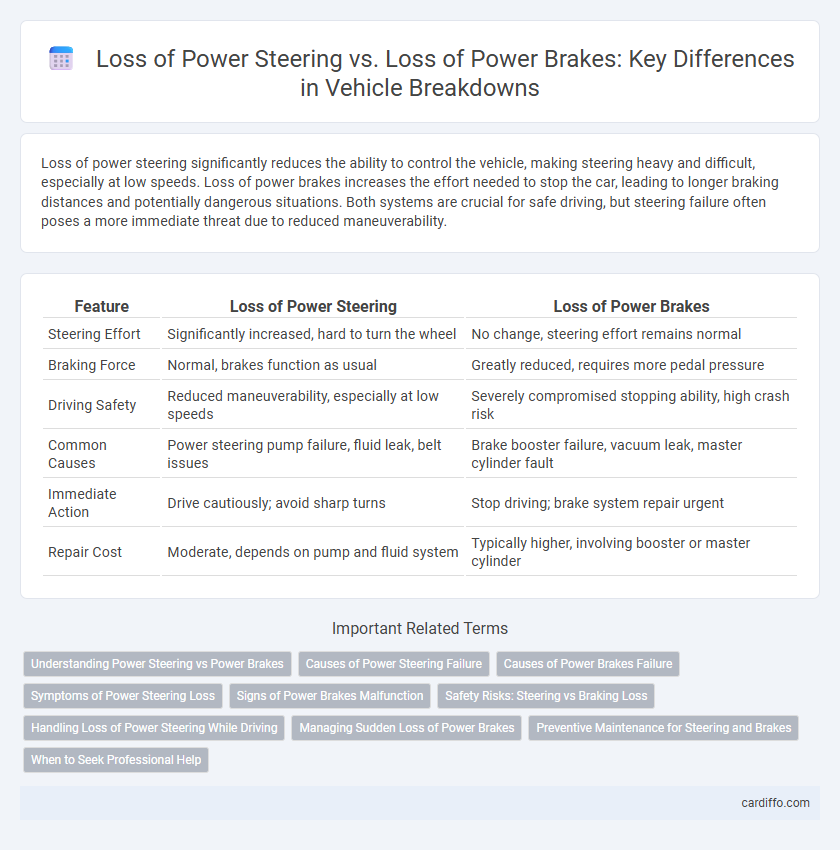Loss of power steering significantly reduces the ability to control the vehicle, making steering heavy and difficult, especially at low speeds. Loss of power brakes increases the effort needed to stop the car, leading to longer braking distances and potentially dangerous situations. Both systems are crucial for safe driving, but steering failure often poses a more immediate threat due to reduced maneuverability.
Table of Comparison
| Feature | Loss of Power Steering | Loss of Power Brakes |
|---|---|---|
| Steering Effort | Significantly increased, hard to turn the wheel | No change, steering effort remains normal |
| Braking Force | Normal, brakes function as usual | Greatly reduced, requires more pedal pressure |
| Driving Safety | Reduced maneuverability, especially at low speeds | Severely compromised stopping ability, high crash risk |
| Common Causes | Power steering pump failure, fluid leak, belt issues | Brake booster failure, vacuum leak, master cylinder fault |
| Immediate Action | Drive cautiously; avoid sharp turns | Stop driving; brake system repair urgent |
| Repair Cost | Moderate, depends on pump and fluid system | Typically higher, involving booster or master cylinder |
Understanding Power Steering vs Power Brakes
Loss of power steering significantly reduces the driver's ability to control the vehicle with ease, requiring greater physical effort to turn the wheel, especially at low speeds. In contrast, loss of power brakes directly impacts stopping power, increasing braking distance and posing a higher safety risk. Understanding the difference between power steering and power brakes is crucial for diagnosing vehicle issues and maintaining safe driving conditions.
Causes of Power Steering Failure
Power steering failure often results from low fluid levels, worn-out pump, or damaged steering rack components causing increased steering effort and unsafe handling. In contrast, loss of power brakes is typically caused by brake fluid leaks, master cylinder failure, or air in brake lines, directly impacting braking performance and safety. Identifying hydraulic fluid contamination, hose deterioration, and belt slippage is essential for diagnosing and repairing power steering issues accurately.
Causes of Power Brakes Failure
Power brakes failure is commonly caused by a leak in the brake booster vacuum hose, a malfunctioning master cylinder, or issues with the brake fluid such as contamination or low levels. Vacuum leaks reduce the brake booster's ability to multiply force, leading to increased pedal effort and reduced braking efficiency. In contrast to power steering loss, which typically stems from hydraulic fluid leaks or pump failure, power brake issues primarily involve vacuum or hydraulic system malfunctions affecting overall stopping power.
Symptoms of Power Steering Loss
Loss of power steering manifests as increased steering effort, especially noticeable at low speeds or during sharp turns, causing the steering wheel to feel heavy and unresponsive. Drivers often experience a whining or groaning noise when turning the wheel, alongside a delay in steering response. Unlike loss of power brakes, which primarily affects stopping distance and pedal firmness, power steering failure directly compromises vehicle maneuverability and control.
Signs of Power Brakes Malfunction
Signs of power brakes malfunction include a hard brake pedal, increased stopping distance, and a spongy or sinking brake pedal feel. Drivers may notice the brake warning light illuminating on the dashboard or experience unusual noises such as hissing or grinding during braking. Immediate inspection of the brake fluid level and brake booster is essential to ensure safe vehicle operation.
Safety Risks: Steering vs Braking Loss
Loss of power steering significantly reduces vehicle control, increasing the risk of accidents due to difficulty in maneuvering, especially at low speeds. In contrast, loss of power brakes severely compromises stopping ability, creating more immediate and dangerous safety risks by prolonging braking distance. Both failures heighten accident potential, but brake failure typically poses a more critical threat to driver and pedestrian safety.
Handling Loss of Power Steering While Driving
Loss of power steering while driving significantly reduces vehicle control, making it harder to steer, especially at low speeds or during sharp turns. Unlike power brakes failure, which primarily affects stopping ability, power steering loss demands greater physical effort to maneuver the wheel, increasing the risk of accidents. Maintaining proper tire pressure and performing regular power steering fluid checks can help prevent sudden steering failures on the road.
Managing Sudden Loss of Power Brakes
Loss of power brakes significantly increases stopping distances, requiring immediate driver adaptation to apply greater pedal force for effective braking. Sudden loss of power brakes demands maintaining calm, pumping the brake pedal to build hydraulic pressure, and using emergency brake gradually to avoid wheel lock-up. Drivers should also downshift gears to slow the vehicle and steer cautiously to the side of the road for a safe stop.
Preventive Maintenance for Steering and Brakes
Loss of power steering often results from low fluid levels, worn belts, or failing pumps, while loss of power brakes typically stems from fluid leaks, worn brake pads, or master cylinder issues. Preventive maintenance for steering includes regular inspection of power steering fluid, hose conditions, and belt tension; for brakes, it involves checking brake fluid levels, pedal response, and pad wear. Maintaining proper fluid levels and timely replacement of worn components reduces the risk of failure and enhances vehicle safety.
When to Seek Professional Help
Loss of power steering significantly reduces vehicle maneuverability, especially at low speeds, making immediate professional assistance crucial to avoid accidents. Loss of power brakes drastically increases stopping distances and requires urgent mechanical inspection to maintain safety. Seeking expert diagnosis promptly ensures timely repairs, preventing further damage and ensuring reliable vehicle control.
Loss of power steering vs loss of power brakes Infographic

 cardiffo.com
cardiffo.com